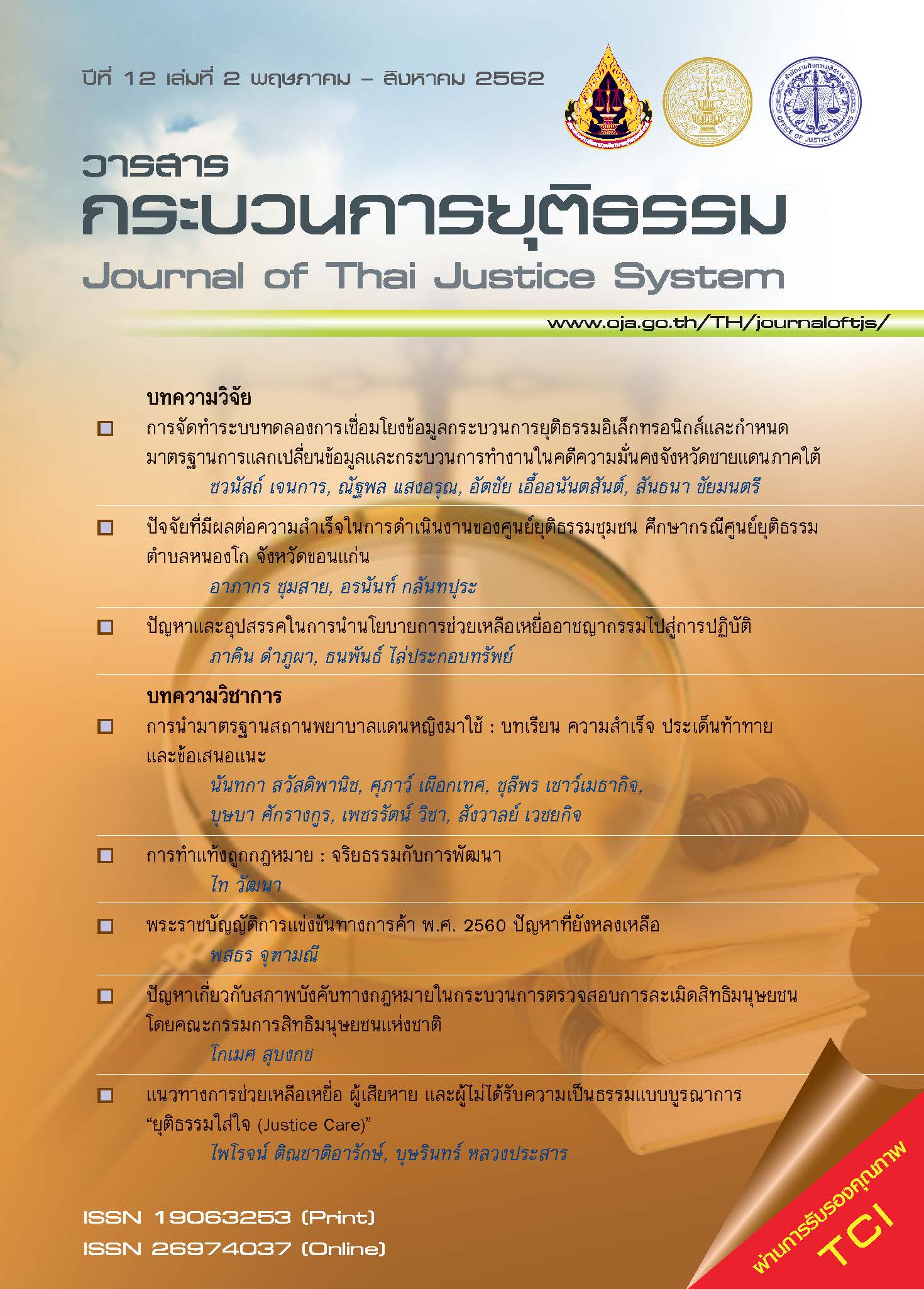การทำแท้งถูกกฎหมาย จริยธรรมกับการพัฒนา
Main Article Content
บทคัดย่อ
ประเด็นเรื่องการทำแท้งนั้น เป็นประเด็นหนึ่งทางสาธารณสุขที่ได้รับความสนใจและมีการถกเถียงอย่างกว้างขวางในระดับโลก โดยแง่มุมในการถกเถียงที่มีความสำคัญคือแง่มุมในเรื่องจริยธรรม ซึ่งหนึ่งในข้อถกเถียงที่สำคัญนั้น คือกฎหมายห้ามการทำแท้งแบบเข้มงวดประสบปัญหาการละเมิดสิทธิเหนือร่างกายของสตรี ในขณะที่แนวคิดการทำแท้งถูกกฎหมายก็ประสบปัญหาการละเมิดสิทธิในชีวิตของทารกด้วยเช่นกัน และอีกหนึ่งแง่มุมที่มีความสำคัญเช่นกันคือแง่มุมการพัฒนา กล่าวคือกฎหมายห้ามทำแท้งแบบเข้มงวด ก่อให้เกิดต้นทุนทางเศรษฐศาสตร์จำนวนมาก เช่น รายจ่ายในการรักษาและดูแลสุขภาพของหญิงประสบภาวะแทรกซ้อนจากการทำแท้งที่ไม่ปลอดภัย เกิดความเสียหายจากอาชญากรรมโดยเด็กที่ถูกทอดทิ้ง ตลอดจนการสูญเสียแรงงานทักษะจากปัญหาวัยรุ่นตั้งครรภ์ไม่พร้อมและต้องออกจากระบบการศึกษา ทำประเทศสูญเสียศักยภาพในการแข่งขัน เป็นต้น สำหรับในประเทศไทยนั้น จัดอยู่ในกลุ่มประเทศที่มีกฎหมายห้ามทำแท้งอย่างเข้มงวดและมีอัตราการทำแท้งที่สูง การนำหลักคิดเรื่องการทำแท้งถูกกฎหมายมาปรับใช้ อาจเป็นทางเลือกหนึ่งในการแก้ไขปัญหาการทำแท้งที่ไม่ปลอดภัย เรื่องถึงปัญหาอื่นๆที่มีประสิทธิภาพมากขึ้นได้ อย่างไรก็ตาม การทำแท้งถูกกฎหมายก็มีต้นทุนทางเศรษฐศาสตร์เช่นกัน จากการที่รัฐต้องลงทุนในการสนับสนุนและกระจายบริการทำแท้งถูกกฎหมายที่ปลอดภัยให้มีคุณภาพและทั่วถึง ดังนั้นภาครัฐจึงควรจัดให้มีการศึกษาวิจัยในเรื่องความคุ้มค่าของการทำแท้งถูกกฎหมายให้มากขึ้น ตลอดจนจัดให้มีการรับฟังความคิดเห็นจากภาคส่วนต่างๆที่เกี่ยวข้องเพื่อให้เกิดการผลักดันร่วมกันอย่างมีประสิทธิภาพมากที่สุด
Article Details

อนุญาตภายใต้เงื่อนไข Creative Commons Attribution-NonCommercial-NoDerivatives 4.0 International License.
ต้นฉบับที่ได้รับการตีพิมพ์ในวารสาร เป็นลิขสิทธิ์ของวารสารกระบวนการยุติธรรม แต่ความคิดเห็นที่ปรากฏในเนื้อหาของบทความในวารสารกระบวนการยุติธรรม ถือเป็นความรับผิดชอบของผู้เขียนแต่เพียงผู้เดียว
เอกสารอ้างอิง
กรมพินิจและคุ้มครองเด็กและเยาวชน. (2556). รายงานสถิติคดี ประจำปี พ.ศ. 2556. กรุงเทพมหานคร:
ศูนย์เทคโนโลยีสารสนเทศ กรมพินิจและคุ้มครองเด็กและเยาวชน.
กรมพินิจและคุ้มครองเด็กและเยาวชน. (2557). รายงานสถิติคดี ประจำปี พ.ศ. 2557. กรุงเทพมหานคร:
ศูนย์เทคโนโลยีสารสนเทศ กรมพินิจและคุ้มครองเด็กและเยาวชน.
กฤตยา อาชวนิจกุล และกนกวรรณ ธราวรรณ. (2543). ขบวนการเคลื่อนไหวทางสังคม บนมิติการเมืองเรื่อง
เพศและร่างกายผู้หญิง. การสัมมนาเรื่อง ขบวนการทางสังคม : พลวัตเศรษฐกิจการเมืองไทย พ.ศ. 2543 กรุงเทพมหานคร.
ขวัญใจ เพทายประกายเพชร และ ปวีณภัทร นิธิตันติวัฒน์. (2559). การตั้งครรภ์ไม่พึงประสงค์และการทำแท้ง:
แนวทางป้องกันสำหรับวัยรุ่น. วารสารวิทยาลัยพยาบาลบรมราชชนนี, 32 (2), 133-146.
ไชยยศ เหมะรัชตะ. (2534). ปัญหากฎหมายทำแท้ง แนวทางการแก้ไขปรับปรุง. จุฬาลงกรณ์สาร, 3(10), 71.
ประมวลกฎหมายอาญา ฉบับอ้างอิง. (2550). (พิมพ์ครั้งที่ 18). กรุงเทพมหานคร: สำนักพิมพ์วิญญูชน.
มูลนิธิเพื่อสุขภาพและสิทธิอนามัยการเจริญพันธุ์ของสตรี (แห่งประเทศไทย). (2561). สถิติและสถานการณ์
การแท้งในประเทศไทย. ค้นจาก https://www.womenhealth.or.th/home-facts-aboriton.html
วิลาสินี พนานครทรัพย์. (2554). การทำแท้ง : มุมมองที่แตกต่าง. วารสารสังคมวิทยามานุษยวิทยา,
30(1), 92-116.
สำนักอนามัยการเจริญพันธุ์. (2557). สถิติการคลอดของแม่วัยรุ่นประเทศไทย ปี พ.ศ. 2556. นนทบุรี:
สำนักงานกิจการโรงพิมพ์องค์การสงเคราะห์ทหารผ่านศึก ในพระบรมราชูปถัมภ์.
อมรวิชช์ นาครทรรพ. (2557). เด็กด้อยโอกาส จุดพลิกผันอนาคตชาติ. ประชุมวิชาการ‘อภิวัฒน์การเรียนรู้…สู่จุดเปลี่ยนประเทศไทย’. นนทบุรี: มาตา การพิมพ์.
UNICEF. (2558). การวิเคราะห์สถานการณ์การตั้งครรภ์ของวัยรุ่นในประเทศไทย รายงานสังเคราะห์ 2558.
กรุงเทพมหานคร: องค์การยูนิเซฟประจำประเทศไทย.
หนังสือต่างประเทศ
Dwyer, S., & Feinberg, J. (1997). The problem of abortion. CA: Wadsworth Pub.
Guttmacher Institute and World Health Organization. (2012). Facts on induced abortion worldwide. [n.p.]. [n.d.].
Levitt, S. D., & Dubner, S. J. (2007). Freakonomics. New York: Clipper Large Print.
United Nations. (2014). Abortion Policies and Reproductive Health around the World. [n.p.]. United Nations publication.


